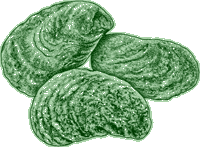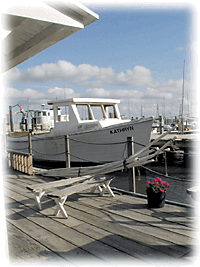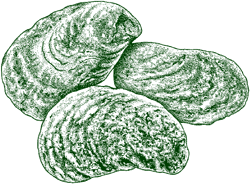 |
|
|||
Objectives Students will be able to:
Materials Large sheets of paper (one for each group of four or five students) Yardsticks (or other straight edge for making the graph) Copy for each Team of: Background Information, oyster harvesting records and significant events cards and year cards Markers, glue/tape, scissors Student Handout — copy for each Team Making Connections The Oyster Industry of the Maurice River Cove — Reprinted from the Bayshore Discovery Project In the southern part of New Jersey, on the shores of the Maurice River, is located the largest oyster- producing region entirely in the jurisdiction of any single state in the union. In fact, we may consider that New Jersey leads the world in oyster production because the yield of oysters in other countries is negligible compared to that of the United States. Both in number of pounds of meats and total value of the product, New Jersey far exceeds any other State. The total value of the industry is more than that of the next two highest competing States combined. Earle B. Perkins, Ph.D. — NJ Oyster Laboratory 1931
(See also Oyster Fact Sheet) (Historic Themes and Resources book pages 46 -51) Reprinted from The Bayshore Discovery Project lesson on Oystering, by Greg DeCowsky From the earliest days of native American settlement on its shores, the Delaware Bay was a highly productive source of seafood. One of the most important resources was the American (or Eastern) oyster. With the coming of European settlers, oystering increased dramatically. Laws to regulate overfishing were passed in 1719 in New Jersey, and in 1812 in Delaware, but they had little effect. In 1876, the railroad came to the Maurice River, making it possible to ship large quantities of oysters, thus causing a boom in the oyster industry. Ten years later, more than 90 railcars of oysters were shipped every week from Bivalve, the center of the New Jersey oyster industry. By the turn of the century, oysters were America’s number one fishery product and New Jersey was the number one oyster supplier. They were a staple part of the region’s diet, and you could buy them from street vendors in Philadelphia, much the way we buy pretzels and hot dogs today. At the height of the fishery, more than 500 schooners and other boats, and 4,000 people worked in commercial oystering in Cumberland County — this is not including the numerous others involved in processing, shipping, shipbuilding, and other industries dependent on the oyster. Entire towns grew up around the oyster industry: Port Norris, Bivalve, Shellpile, and Maurice River in South Jersey; Bowers Beach, Leipsic, and Little Creek in Delaware. At the peak of the oyster fishery, Port Norris could claim more millionaires than any other town in New Jersey! The prosperity extended throughout the region, even as far as Philadelphia, where some business and ship shareholders were based. Most of the ships used in oystering on the Delaware Bay were built on the Maurice and Cohansey Rivers: Leesburg, Dorchester, and Greenwich were among several major South Jersey shipbuilding centers. The A.J. Meerwald was built in Dorchester in 1928. It’s typical of the later style of wooden, two-masted, “Bald-headed,” centerboard schooners used in the Delaware Bay for oyster dredging. Most of the oysters were taken by dredging from sailboats: dragging a rake-like device with a mesh bag across the bottom. (On the Chesapeake Bay, hand or mechanical tongs or diving are used too, but dredging has long been the method of choice on Delaware Bay.) This method yields large quantities of oysters with comparatively little effort, but it tends to flatten the oyster beds, making it more likely that they will be buried in the mud. On the Delaware Bay, oysters are usually dredged from "Seed" beds in the spring and "Planted" on other beds to grow out to market size (3" is the legal minimum). Oyster planting in the Delaware Bay was first done in the 1820’s in the Maurice River Cove and off Port Mahon and Little Creek in Delaware. After World War II, dredging under power was allowed, and most of the old schooners cut down their masts and converted to power, allowing more oysters to be caught with less effort. In the late 1950’s, Delaware Bay oystering collapsed, primarily because of an oyster disease called MSX. The oyster catches dropped 98% in two seasons. The industry has never recovered, and the loss of the oyster business turned many south Jersey and Delaware communities into ghost towns. MSX and another oyster disease, called Dermo, have continued to prevent the restoration of a commercially viable oyster fishery, and much scientific knowledge about the diseases has been gained due to extensive research. It is not (and may never be) certain whether humans helped cause the decline of oyster population, although there are several possibilities:
Oyster Biology/Pollution Effects (Where is the natural hard bottom of the Delaware Bay?) One of the most interesting things about the oyster is that it can actually clean the water it lives in! The oyster feeds by pumping water through its body and filtering out its food (mostly algae and detritus — decaying plant material). A healthy market-size oyster can filter 50 or more gallons of water a day! Also, a natural oyster bed provides the habitat — shelter and food — for a community that includes many other organisms: plants, crabs, worms, fish, etc. Among the creatures you may see are such predators as oyster drills, moon snails, or whelks, snails that feed on oysters by drilling holes through the shells. What else eats oysters? The spat or larvae are very vulnerable. They are eaten by a wide variety of fish and invertebrates. Large oysters may be eaten by crabs, fish ( rays, skates, drum), starfish, worms, or birds (i.e., oystercatchers). Boring sponges are commensal, meaning that they use the shell as their home. They don’t actually eat the oysters, but they can kill them. Oyster spawn or reproduce (mostly in summer) by releasing eggs and sperm into the water. Usually almost all the oysters in a bed will spawn at once when the temperature reaches about 70° F. The fertilized eggs become larvae ("spat") which eventually settle and attach themselves ("set") to hard bottom, usually another oyster’s shell. So, it’s important to return old shell to the oyster beds. A practice long ago started by the oystermen in the Delaware Bay. Although it’s not known for sure whether human activities promoted the spread of oyster diseases, it’s generally true that when an organism is stressed (by pollution, climate, inadequate food, etc.), it becomes more susceptible to disease or predation (so that in nature, weakened members of a species are often "weeded" out). So, an oyster choked by sediment or sickened by disease MAY be more likely to die of disease. One of the problems for oysters is the erosion of sediment (soil) from the land, especially land from which the natural plant cover has been removed. Sediment in the water can "choke" an oyster’s gills, slowing both breathing and feeding. It can also settle out and cover oyster beds, cutting off their supply of clean, oxygen-containing water. Excess sediment can be the result of what is called Nonpoint Source Pollution (or NPS), which is pollution that can’t be traced back to a particular point. NPS pollution consists largely of runoff from farms, streets, and lawns, and often carries pesticides, fertilizers, oils, and other toxic materials, as well as sediment. Forests and wetlands tend to act as filters or sponges, absorbing rainwater — and NPS pollution — before it reaches the River and Bay. Paved land doesn’t absorb rainwater, but funnels runoff, and the pollutants it carries, directly into streams before it can be filtered through the soil and plants. Sediment has also created new shoals (sand bars) and mud flats, and filled in many streams and channels. For example, Mauricetown was formerly a deepwater port for oceangoing ships, however, few of those ships could get there today. Other ports, and indeed the main River-Bay channel, need frequent dredging to keep them open. Perhaps the channel (and the transportation it allows) is too deep for the system to support? This dredging can cause sediment and other contaminants that have already settled out to be resuspended in the water, exposing oysters and other animals to the "recycled" pollution. Under-dredged ports lose their access to trade, and often become ghost towns. Procedure Warm Up The Activity
Part Two
Wrap Up Sample questions include: (student handout — one copy for each team)
Action (Optional) Students could extrapolate the estimated oyster harvest for the future based on current trends for the year 2,000, 2005, 2010, etc. Using the Collecting Oral Histories activity, students could identify and conduct interviews of a variety of people who were somehow impacted by the oyster “rise and fall.” Students could individually research and investigate one of the “significant events” presented for this activity. Their findings could be presented to the class. Assessment Student teams should each present their findings orally to the class. Students could decorate their posters with drawings, illustrations, etc. to go with each major event. Display them on a bulletin board, around the classroom, etc. Extensions Comparing different modes of transportation A sample Math problem: If 90 rail cars of oysters were leaving Bivalve every week in 1886, how many tons, bushels, gallons of oysters were being shipped out of there? How many trucks would that same amount require? Why was the railroad so critical to the oyster industry? Investigate the impact of refrigeration on the oyster industry. Please download the PDF for the complete Lesson Plan.
Beneath the Shell, NJDEP, Office of Environmental Planning, CN 412, Trenton, NJ 08625, Haskins Research Laboratory, Bivalve Living Resources of the Delaware Estuary. Produced by The Delaware Estuary Program. Ford, S.E., Haskin, H.H., and Kraeuter, J.N. 1995 Eastern Oyster. Pages 105-111 in L.E. Dove and R.M. Nyman, eds. The Bayshore Discovery Project, both Museum and activities aboard the AJ Meerwald. |
|||

 Relating the historical harvest of oysters to significant events that impacted the industry will show the significance of the relationship that existed in the Down Jersey region between man, the sea, and its resources.
Relating the historical harvest of oysters to significant events that impacted the industry will show the significance of the relationship that existed in the Down Jersey region between man, the sea, and its resources.  Background
Background  How has the oyster harvest changed over time?
How has the oyster harvest changed over time?